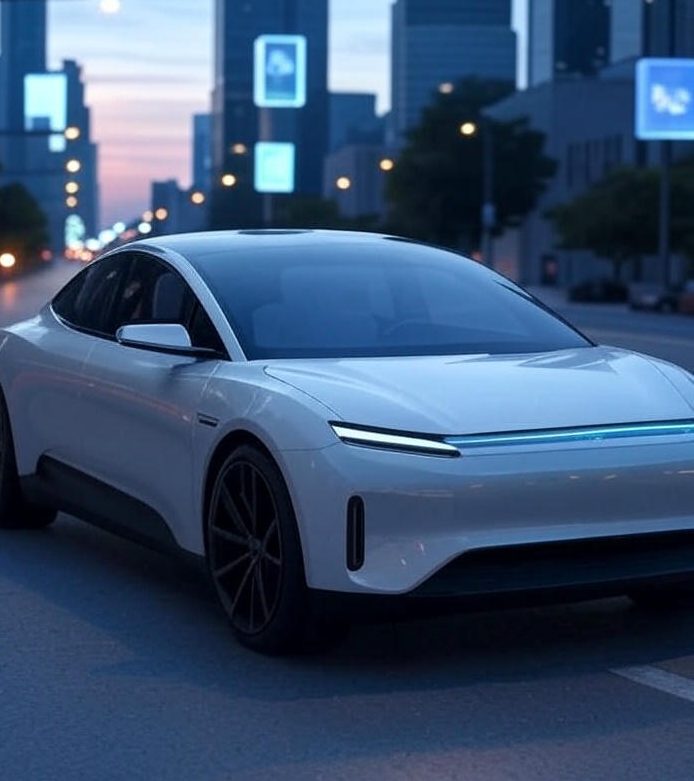
Software-defined vehicles (SDVs) are transforming the automotive industry, shifting the focus from mechanical engineering to software-driven ecosystems. By leveraging advanced software, connectivity, and data analytics, SDVs enable unprecedented customization, efficiency, and innovation. In 2025, this trend is accelerating, reshaping how vehicles are designed, operated, and experienced. This blog explores the core of SDVs, their trending advancements, impacts, and challenges in the evolving mobility landscape.
What Are Software-Defined Vehicles?
SDVs prioritize software over hardware, using centralized computing architectures to control vehicle functions. Unlike traditional cars, where systems like braking or infotainment operate independently, SDVs integrate these through a centralized domain controller. This enables over-the-air (OTA) updates, real-time data processing, and seamless integration with cloud platforms. Powered by artificial intelligence (AI), machine learning, and 5G connectivity, SDVs adapt to user preferences, environmental conditions, and technological advancements dynamically.
Trending Innovations in SDVs for 2025
1. OTA Updates for Continuous Improvement
SDVs receive OTA updates, similar to smartphones, enhancing performance, safety, and features without dealership visits. Automakers like Tesla and Rivian deploy updates to refine autonomous driving, optimize battery management, or introduce new infotainment options, ensuring vehicles evolve post-purchase.
2. AI-Personalized User Experiences
AI tailors the driving experience. Voice assistants, powered by natural language processing (NLP), adjust settings like climate control or seating based on driver preferences. Behavioral analytics adapt interfaces, recommending routes or entertainment based on habits, creating a bespoke cabin experience.
3. Vehicle-to-Everything (V2X) Connectivity
SDVs leverage 5G and V2X communication to interact with infrastructure, other vehicles, and cloud systems. This enables real-time traffic optimization, predictive maintenance, and enhanced collision avoidance, making roads safer and more efficient.
4. Software-Driven Autonomy
SDVs are the backbone of Level 4 and Level 5 autonomous driving. Centralized software integrates LiDAR, radar, and camera data for precise navigation. Edge computing ensures split-second decisions, while cloud-based AI refines algorithms based on global fleet data.
5. Electrification Synergy
SDVs align with electric vehicles (EVs), optimizing battery management systems (BMS) through software. Real-time analytics extend range, while inductive charging and vehicle-to-grid (V2G) integration support sustainable energy ecosystems.
Impacts on Society and Industry
1. Enhanced Safety and Reliability
Software-driven advanced driver-assistance systems (ADAS) reduce human error, which causes over 90% of accidents. Predictive analytics monitor vehicle health, preventing failures. Centralized architectures simplify diagnostics, ensuring consistent performance.
2. Mobility as a Service (MaaS)
SDVs power robotaxi fleets and shared mobility platforms. Companies like Waymo and Cruise use software to manage driverless fleets, offering affordable, on-demand transport. This reduces car ownership and urban congestion.
3. Economic Transformation
SDVs shift value from hardware to software, creating opportunities for tech companies and startups. Traditional automakers partner with firms like NVIDIA or Qualcomm to develop system-on-chip (SoC) platforms. However, job displacement in manufacturing requires reskilling initiatives.
4. Urban and Environmental Benefits
SDVs enable smart city integration. Traffic optimization algorithms reduce congestion, while eco-driving modes lower emissions. Repurposing parking spaces for green areas becomes feasible as shared SDV fleets dominate.
5. Subscription-Based Revenue
Automakers introduce subscription models for premium features like enhanced autonomy or infotainment packages. This creates recurring revenue, shifting the industry from one-time sales to service-based models.
Challenges Facing SDVs
1. Cybersecurity Threats
Connected SDVs are vulnerable to hacking. Robust encryption, zero-trust architectures, and intrusion detection systems are critical to protect against data breaches or remote takeovers.
2. Regulatory Complexity
Global standards for SDV safety, data privacy, and OTA updates vary. Harmonizing regulations across regions is essential for scalability. Governments must address software liability and certification processes.
3. Interoperability Issues
SDVs require seamless integration with diverse infrastructure and vehicle ecosystems. Lack of standardized protocols hinders V2X adoption. Industry collaboration is needed to ensure compatibility.
4. Consumer Trust
High-profile incidents erode confidence in SDVs. Transparent testing, explainable AI, and public education campaigns are vital to demonstrate reliability and safety.
5. High Development Costs
Building SDV platforms demands significant investment in R&D, cloud infrastructure, and talent acquisition. Smaller automakers struggle to compete, necessitating strategic partnerships.
The Global SDV Landscape
The SDV market is a battleground for innovation. China leads with state-supported programs and companies like XPeng and NIO, integrating AI and 5G at scale. In the U.S., General Motors and Ford advance SDV platforms, while Tesla sets the benchmark for OTA updates. Europe emphasizes safety and sustainability, with BMW and Volkswagen developing open-source software ecosystems. Emerging markets like India focus on affordable SDVs for dense urban environments.
The Road Ahead for SDVs
By 2030, SDVs are projected to dominate the automotive market, with software accounting for 40% of vehicle value. Autonomous fleets will redefine urban mobility, reducing traffic and emissions. Smart infrastructure investments will accelerate adoption, while workforce reskilling addresses job transitions. However, success hinges on overcoming technical, regulatory, and societal hurdles.
Automakers must prioritize user-centric design, ensuring SDVs are intuitive and inclusive. Public-private partnerships will drive infrastructure upgrades, while open-source platforms foster collaboration. As SDVs evolve, they promise a future where mobility is safer, greener, and more connected.
Conclusion
Software-defined vehicles are revolutionizing transportation, blending cutting-edge software with automotive engineering. From personalized experiences to autonomous capabilities, SDVs unlock new possibilities for drivers, cities, and industries. While challenges like cybersecurity and regulation persist, the momentum behind SDVs is unstoppable. As technology advances and ecosystems align, SDVs will pave the way for a smarter, more sustainable mobility future.









